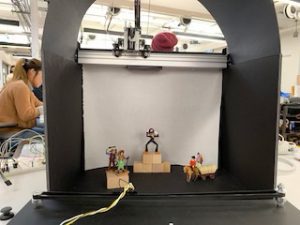Yiting Liu
A physical interactive platform that allows you to learn traditional Chinese/ Indian cuisine through visual representation.
https://yitingliu97.wordpress.com/2019/12/05/fusion-or-not-update-pcomp-week11/
Description
The physical interactive platform includes a big mixing bowl in the center with four ingredients bowls around. The platform will be projected with the p5 sketched on top of it.
Users are prompted to push the “START” button to initiate the act of mixing ingredients. They only have 30 seconds to make a traditional Indian or Chinese cuisine. They have to reach inside the bowl to trigger the motion sensor which will be displayed on the projected visual representation.


The ingredient chosen will be put into a bowl and users are prompted to rotate the encoder to select different layers of ingredients. When the time is up or three layers are selected, the game is over. The screen will compare the chosen ingredients with the right ingredients for the cuisine and users are promoted to scan the QR code to download the traditional cuisine to learn.
Classes
Introduction to Computational Media: Media, Introduction to Physical Computing









